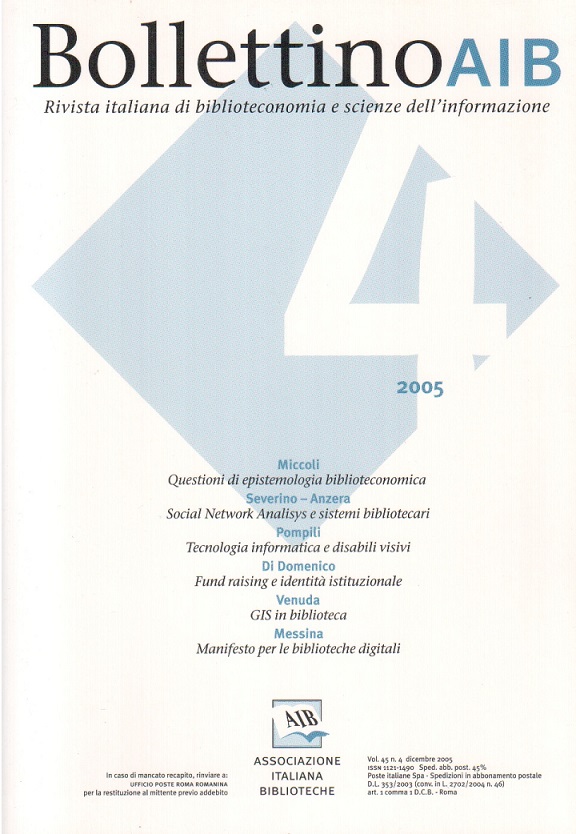GIS (Geographic Information System) in libraries: II part
Main Article Content
Abstract
The library has to show its own advantage to be able to go on growing and raising funds to exist, to work and to develop. Therefore the library needs to know in depth the area on which it operates, constantly striving to adapt its services to its features, and becoming a point of reference for the community information and knowledge needs.
GIS (Geographic Information System) technology can help the library reach these two objectives, both as analysis and management tool to support the marketing activities, and as enhancement of the traditional Reference Service.
A GIS application enables to relate textual and descriptive data to geographic information, to manipulate and analyse these data, to obtain results from this relationship and to display them on the territory through digital maps; these maps are constituted by superimposing information layers, which, through defined graphical symbols, represent on the region events, conditions and objects whose features are expressed by the descriptive data used.
So that every layer is superimposing the others, it has to be georeferenced and therefore it has to use the same frame of reference (i.e. coordinates) used for the other layers, it has to represent the same area of Earth's surface and to use the same scale.
Many are the application of GIS technology, which for years have been used in the most diverse fields, for instance in the management of technological networks and of vehicle fleets, or in carrying out the e-government policy.
The library can take advantage from this technology applying it to two macro areas: in-house projects and public services. In the first case, in the perspective of the strategic planning of services, the library can use gis to define and plan its own set-up in relation to the territory, by measuring and defining its market area, and in relation to the community by tracing the actual profile of feature and needs for its actual and potential users (market profile).
In the second case, the library creates a GIS Reference Service, as an enhancement of the traditional services, to support the activity of community information and to give access to the manifold gis application available for the users. There are several level of Reference Services, which can be activated depending on the availability of human and financial resources, and depending on the information needs of the community.
Many are the software available to create a GIS service, either local or remote; many are traded by companies, while others are freely available through GPL license. In U.S. an online service devoted to libraries, LibraryDecision, is available through subscription; this service supplies data and geographic analysis tools to support marketing activities.
GIS (Geographic Information System) technology can help the library reach these two objectives, both as analysis and management tool to support the marketing activities, and as enhancement of the traditional Reference Service.
A GIS application enables to relate textual and descriptive data to geographic information, to manipulate and analyse these data, to obtain results from this relationship and to display them on the territory through digital maps; these maps are constituted by superimposing information layers, which, through defined graphical symbols, represent on the region events, conditions and objects whose features are expressed by the descriptive data used.
So that every layer is superimposing the others, it has to be georeferenced and therefore it has to use the same frame of reference (i.e. coordinates) used for the other layers, it has to represent the same area of Earth's surface and to use the same scale.
Many are the application of GIS technology, which for years have been used in the most diverse fields, for instance in the management of technological networks and of vehicle fleets, or in carrying out the e-government policy.
The library can take advantage from this technology applying it to two macro areas: in-house projects and public services. In the first case, in the perspective of the strategic planning of services, the library can use gis to define and plan its own set-up in relation to the territory, by measuring and defining its market area, and in relation to the community by tracing the actual profile of feature and needs for its actual and potential users (market profile).
In the second case, the library creates a GIS Reference Service, as an enhancement of the traditional services, to support the activity of community information and to give access to the manifold gis application available for the users. There are several level of Reference Services, which can be activated depending on the availability of human and financial resources, and depending on the information needs of the community.
Many are the software available to create a GIS service, either local or remote; many are traded by companies, while others are freely available through GPL license. In U.S. an online service devoted to libraries, LibraryDecision, is available through subscription; this service supplies data and geographic analysis tools to support marketing activities.
Article Details
Section
Articles

This work is licensed under a Creative Commons Attribution-ShareAlike 4.0 International License.
